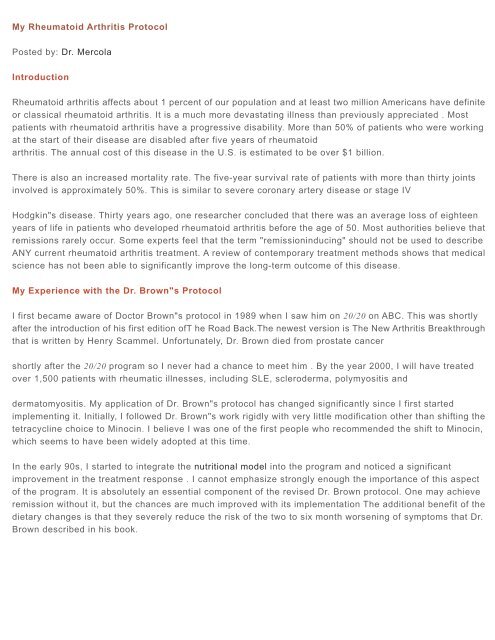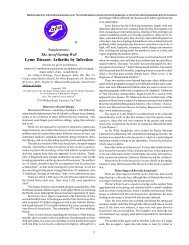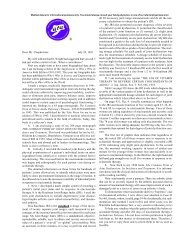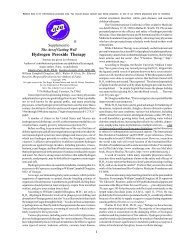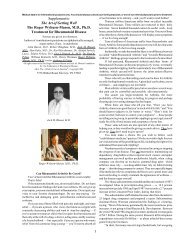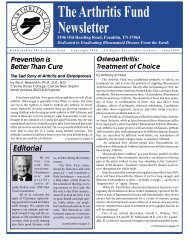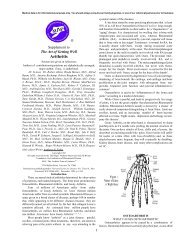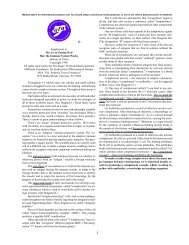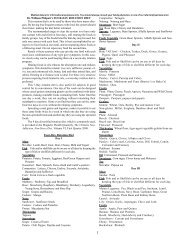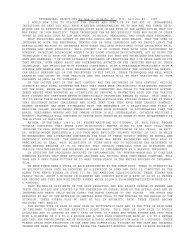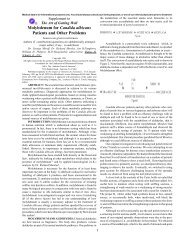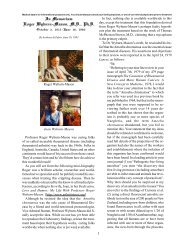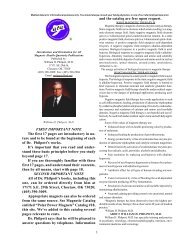My Rheumatoid Arthritis Protocol Posted by - Arthritis Trust of America
My Rheumatoid Arthritis Protocol Posted by - Arthritis Trust of America
My Rheumatoid Arthritis Protocol Posted by - Arthritis Trust of America
You also want an ePaper? Increase the reach of your titles
YUMPU automatically turns print PDFs into web optimized ePapers that Google loves.
<strong>My</strong> <strong>Rheumatoid</strong> <strong>Arthritis</strong> <strong>Protocol</strong><br />
<strong>Posted</strong> <strong>by</strong>: Dr. Mercola<br />
Introduction<br />
<strong>Rheumatoid</strong> arthritis affects about 1 percent <strong>of</strong> our population and at least two million <strong>America</strong>ns have definite<br />
or classical rheumatoid arthritis. It is a much more devastating illness than previously appreciated . Most<br />
patients with rheumatoid arthritis have a progressive disability. More than 50% <strong>of</strong> patients who were working<br />
at the start <strong>of</strong> their disease are disabled after five years <strong>of</strong> rheumatoid<br />
arthritis. The annual cost <strong>of</strong> this disease in the U.S. is estimated to be over $1 billion.<br />
There is also an increased mortality rate. The five-year survival rate <strong>of</strong> patients with more than thirty joints<br />
involved is approximately 50%. This is similar to severe coronary artery disease or stage IV<br />
Hodgkin"s disease. Thirty years ago, one researcher concluded that there was an average loss <strong>of</strong> eighteen<br />
years <strong>of</strong> life in patients who developed rheumatoid arthritis before the age <strong>of</strong> 50. Most authorities believe that<br />
remissions rarely occur. Some experts feel that the term "remissioninducing" should not be used to describe<br />
ANY current rheumatoid arthritis treatment. A review <strong>of</strong> contemporary treatment methods shows that medical<br />
science has not been able to significantly improve the long-term outcome <strong>of</strong> this disease.<br />
<strong>My</strong> Experience with the Dr. Brown"s <strong>Protocol</strong><br />
I first became aware <strong>of</strong> Doctor Brown"s protocol in 1989 when I saw him on 20/20 on ABC. This was shortly<br />
after the introduction <strong>of</strong> his first edition <strong>of</strong>T he Road Back.The newest version is The New <strong>Arthritis</strong> Breakthrough<br />
that is written <strong>by</strong> Henry Scammel. Unfortunately, Dr. Brown died from prostate cancer<br />
shortly after the 20/20 program so I never had a chance to meet him . By the year 2000, I will have treated<br />
over 1,500 patients with rheumatic illnesses, including SLE, scleroderma, polymyositis and<br />
dermatomyositis. <strong>My</strong> application <strong>of</strong> Dr. Brown"s protocol has changed significantly since I first started<br />
implementing it. Initially, I followed Dr. Brown"s work rigidly with very little modification other than shifting the<br />
tetracycline choice to Minocin. I believe I was one <strong>of</strong> the first people who recommended the shift to Minocin,<br />
which seems to have been widely adopted at this time.<br />
In the early 90s, I started to integrate the nutritional model into the program and noticed a significant<br />
improvement in the treatment response . I cannot emphasize strongly enough the importance <strong>of</strong> this aspect<br />
<strong>of</strong> the program. It is absolutely an essential component <strong>of</strong> the revised Dr. Brown protocol. One may achieve<br />
remission without it, but the chances are much improved with its implementation The additional benefit <strong>of</strong> the<br />
dietary changes is that they severely reduce the risk <strong>of</strong> the two to six month worsening <strong>of</strong> symptoms that Dr.<br />
Brown described in his book.
In the late 80s, the common retort from other physicians was that there was "no scientific pro<strong>of</strong>' that this<br />
treatment works . Well, that is certainly not true today. If one peeks ahead at the bibliography, one will<br />
find over 200 references in the peer-reviewed medical literature that supports the application <strong>of</strong>Minocin<br />
in the use <strong>of</strong> rheumatic illnesses.<br />
The definitive scientific support for minocycline<br />
in the treatment <strong>of</strong> rheumatoid arthritis came with the MIRA trial in the United States. This was a double blind<br />
randomized placebo controlled trial done at six university centers involving 200 patients for nearly one year.<br />
The dosage they used (100 mg twice daily) was much higher and likely less effective than what most clinicians<br />
currently use.<br />
They also did not employ any additional antibiotics or nutritional regimens, yet 55% <strong>of</strong>the patients<br />
improved . This study finally provided the "pro<strong>of</strong>' that many traditional clinicians demanded before<br />
seriously considering this treatment as an alternative regimen for rheumatoid arthritis .<br />
Dr. Thomas Brown"s effort to treat the chronic mycoplasma infections believed to cause rheumatoid<br />
arthritis is the basis for this therapy. Dr. Brown believed that most rheumatic illnesses respond to this<br />
treatment. He and others used this therapy for SLE, ankylosing spondylitis, scleroderma,<br />
dermatomyositis and polymyositis.<br />
Dr. Osler was also a preeminent figure <strong>of</strong> his time (1849- 1919). Many regard him as the consummate<br />
physician <strong>of</strong> modern times . An excerpt from a commentary on Dr. William Osler provides a useful<br />
perspective on application <strong>of</strong> alternative medical paradigms :<br />
Osler would be receptive to the cautious exploration <strong>of</strong> nontraditional methods <strong>of</strong> treatment, particularly<br />
in situations in which our present science has little to <strong>of</strong>fer. From his reading <strong>of</strong> medical history, he would<br />
know that many pharmacologic agents were originally derived from folk medicine. He would also<br />
remember that in the 19th century physicians no less intelligent than those in our own day initially<br />
ridiculed the unconventional practices <strong>of</strong> Semmelweis and Lister.<br />
Osler would caution us against the arrogance <strong>of</strong> believing that only our current medical practices can<br />
benefit the patient. He would realize that new scientific insights might emerge from as yet unproved<br />
beliefs. Although he would fight vigorously to protect the public against frauds and charlatans, he would<br />
encourage critical study <strong>of</strong> whatever therapeutic approaches were reliably reported to be beneficial to<br />
patients.<br />
Revised Antibiotic-Free Approach<br />
Although the antibiotics frequently worked and the six-month period <strong>of</strong> worsening that was part <strong>of</strong> Dr.<br />
Brown"s protocol was virtually eliminated, I always felt like I had failed because I had to resort to the use<br />
<strong>of</strong> antibiotics .<br />
This has now changed, as I have been able to implement a major change in my revision <strong>of</strong> the protocol<br />
that allows for a completely drug-free treatment <strong>of</strong> RA. The major change seems to be the use <strong>of</strong><br />
nutritional typing, along with energy techniques. Since we have integrated nutritional typing with full use<br />
<strong>of</strong> EFT to address the stressors that seem to be universally present in RA, we have been able to cause<br />
RA to routinely go into remission without the use <strong>of</strong> antibiotics.
To say I am excited is a serious understatement.<br />
nutritional typing allows each patient to get a unique diet that is right for their body. It is very easy to<br />
understand how a physician who successfully treats one patient with a particular diet would come to the<br />
conclusion that the diet that person was on was the "cure" for RA, when in fact nothing could be further<br />
from the truth. Another person with the same disease could quite possibly need an entirely different diet<br />
to receive any benefits, that is how powerful nutritional typing can be.<br />
If you haven"t yet read the book The nutritional typing Diet, I would strongly encourage you to do so as it<br />
reviews these topics extensively (it is definitely a book that belongs on the shelf <strong>of</strong> anyone with any<br />
interest in nutrition).<br />
There are some general principles that seem to hold true for all nutritional types and these include:<br />
•'95 Eliminating sugar and grains (you can read more about this below)<br />
•'95 Having unprocessed, high-quality foods, organic if possible<br />
Eating your food as close to raw as possible<br />
Having omega-3 fish oil<br />
I am overjoyed beyond belief that after 14 years <strong>of</strong> treating RA I can finally <strong>of</strong>fer a drug-free, effective<br />
and rapid solution for most <strong>of</strong> those with RA with the aid <strong>of</strong> nutritional typing. However, it is clear that a<br />
perfect diet alone will rarely cause the RA to go into remission.<br />
This is because RA is an autoimmune illness. It does indeed appear to be caused <strong>by</strong> an infection, as Dr.<br />
Brown speculated. But the central issue is why did the person acquire the infection in the first place? It is<br />
my experience that this infection is usually acquired when a person has a stressful event that causes a<br />
disruption in their bioelectrical circuits, which causes an impairment in their immune system. This<br />
impairment predisposes them to developing the initial infection and also contributes to their relative<br />
inability to effectively defeat the infection .<br />
The antibiotics clearly seem to help most people fight the infection, but, as I mention above, there are<br />
better ways that address the underlying foundational cause <strong>of</strong> the illness.<br />
I am quite convinced that energy techniques are required to resolve this energetic disruption. Prayer can<br />
certainly be one <strong>of</strong> them. However, in my experience, most have not utilized prayer in a way that rallies<br />
their body"s resources to resolve the problem.<br />
In my experience, energy psychology techniques are very helpful in this area and can be easily<br />
integrated with prayer. I happen to use EFT in my practice and you can download my free 25-page<br />
report to find out more about this technique<br />
However, the emotional trauma that causes RA is nearly universally quite severe and is best treated <strong>by</strong><br />
a pr<strong>of</strong>essional. Trying to treat this trauma <strong>by</strong> yourself is somewhat similar to a general surgeon trying to<br />
perform an appendectomy on him or herself. Although it is possible, it is not generally recommended<br />
(Interesting aside : I read an article in JAMA about 10 years ago in which a surgeon in the late 1800s<br />
actually did this. Unfortunately, he died from complications .)
Dr. Partirica Carrington has actually compiled some guidelines on how you can find an EFT practitioner.<br />
In the following sections I have included information about the antibiotic therapy for RA for anyone who<br />
is interested . However, I now recommend my drug-free approach for anyone fighting this illness.<br />
Nutritional Considerations<br />
Limiting sugar is a critical element <strong>of</strong> the treatment program. Sugar has multiple significant negative<br />
influences on a person"s biochemistry . Its major mode <strong>of</strong> action is through elevation <strong>of</strong> insulin levels.<br />
However, it has a similarly severe impairment <strong>of</strong> intestinal micr<strong>of</strong>lora. Patients who are unable to<br />
decrease their sugar intake are far less likely improve.<br />
One <strong>of</strong> the major benefits <strong>of</strong> implementing the dietary changes is that one does not seem to develop<br />
worsening <strong>of</strong> symptoms the first three to six months that is described in Dr. Brown"s book. Most <strong>of</strong> my<br />
patients tend to not worsen once they start the antibiotics. I believe this is due to the beneficial effects<br />
that the diet has on the immune response.<br />
Antibiotic Therapy With Minocin<br />
There are three different tetracyclines available: simple tetracycline, doxycycline, or Minocin<br />
(minocycline). Minocin has a distinct and clear advantage over tetracycline and doxycycline in three<br />
important areas.<br />
1. Extended spectrum <strong>of</strong> activity<br />
2. Greater tissue penetrability<br />
3. Higher and more sustained serum levels<br />
Bacterial cell membranes contain a lipid layer. One mechanism <strong>of</strong> building up a resistance to an<br />
antibiotic is to produce a thicker lipid layer. This layer makes it difficult for an antibiotic to penetrate.<br />
Minocin"s chemical structure makes it the most lipid soluble <strong>of</strong> all the tetracyclines
This difference can clearly be demonstrated when one compares the drugs in the treatment <strong>of</strong> two<br />
common clinical conditions . Minocin gives consistently superior clinical results in the treatment <strong>of</strong> chronic<br />
prostatitis. In other studies, Minocin was used to improve between 75-85% <strong>of</strong> patients whose acne had<br />
become resistant to tetracycline. Strep is also believed to be a contributing cause to many patients with<br />
rheumatoid arthritis . Minocin has shown significant activity against treatment <strong>of</strong> this organism.<br />
There are several important factors to consider when using Minocin.<br />
Unlike the other tetracyclines,<br />
it tends not to cause yeast infections. Some infectious disease experts even believe that it even has a<br />
mild anti-yeast activity . Women can be on this medication for several years and not have any vaginal<br />
yeast infections. Nevertheless, it would be prudent to have patients on prophylactic oral Lactobacillus<br />
acidophilus and bifidus preparations. This will help to replace the normal intestinal flora that is killed with<br />
the Minocin.<br />
Another advantage <strong>of</strong> Minocin is that it tends not to sensitize patients to the sun. This minimizes the risk<br />
<strong>of</strong> sunburn and increased risk <strong>of</strong> skin cancer. However, one must incorporate several precautions with<br />
the use <strong>of</strong> Minocin. Like other tetracyclines, food impairs its absorption. However, the absorption is much<br />
less impaired than with other tetracyclines . This is fortunate because some patients cannot tolerate<br />
Minocin on an empty stomach. They must take it with a meal to avoid GI side effects . If they need to take<br />
it with a meal, they will still absorb 85% <strong>of</strong> the medication, whereas tetracycline is only 50% absorbed. In<br />
June <strong>of</strong> 1990, a pelletized version <strong>of</strong> Minocin became available. This improved absorption when taken<br />
with meals. This form is only available in the non-generic Lederle brand and is a more than reasonable<br />
justification to not substitute for the generic version. Clinical experience has shown that many patients<br />
will relapse when they switch from the brand name to the generic. In February 2006 Wyeth sold<br />
manufacturing rights <strong>of</strong> Minocin to Triax Pharmaceuticals (866-488-7429).<br />
Clinically it has been documented that it is important to take Lederle brand M inocin. Most all generic<br />
minocycline is clearly not as effective. A large percentage <strong>of</strong> patients will not respond at all or not do<br />
as well with generic non-Lederle minocycline.<br />
Traditionally it was recommended to only receive the brand name Lederle Minocin. However, there is<br />
one generic brand that is acceptable and that is the brand made <strong>by</strong> Lederle. The only difference<br />
between Lederle generic Minocin and brand name Minocin is the label and the price.<br />
The problem is finding the Lederle brand generic. Some <strong>of</strong> my patients have been able to find it at Wal<br />
Mart. Since Wal Mart is one <strong>of</strong> the largest drug chains in the US, this should make the treatment more<br />
widely available for a reduced charge .<br />
Many patients are on NSAID"s which contribute to microulcerations <strong>of</strong> the stomach which cause chronic<br />
blood loss. It is certainly possible they can develop a peptic ulceration contributing to their blood loss. In<br />
either event, patients frequently receive iron supplements to correct their blood counts.<br />
IT IS IMPERATIVE THAT MINOCIN NOT BE GIVEN WITH IRON.<br />
Over 85% <strong>of</strong> the dose will bind to the<br />
iron and pass through the colon unabsorbed. If iron is taken, it should be at least one hour before the<br />
minocin or two hours after. One recent uncommon complication <strong>of</strong> Minocin is a cell-mediated<br />
hypersensitivity pneumonitis .
Most patients can start on Minocin 100 mg . every Monday, Wednesday, and Friday evening .<br />
Doxycycline can be substituted for patients who cannot afford the more expensive Minocin . It is<br />
important to not give either medication daily, as this does not seem to provide as great a clinical benefit.<br />
Tetracycline type drugs can cause a permanent yellow- grayish brown discoloration <strong>of</strong> the teeth .<br />
This can occur in the last half <strong>of</strong> pregnancy and in children up to eight years old. One should not<br />
routinely use tetracycline in children. If patients have severe disease, one can consider increasing the<br />
dose to as high as 200 mg three times a week. Aside from the cost <strong>of</strong> this approach, several problems<br />
result may result from the higher doses. Minocin can cause quite severe nausea and vertigo. Taking the<br />
dose at night does tend to decrease this problem considerably.<br />
However, if one takes the dose at bedtime, one must tell the patient to swallow the medication with TWO<br />
g lasses <strong>of</strong> water. Th is is to insu re that the capsule doesn"t get stuck in the throat. If that occu rs, a severe<br />
chemical esophagitis can result which can send the patient to the emergency room<br />
For those physicians who elect to use tetracycline or doxycycline for cost or sensitivity reasons, several<br />
methods may help lessen the inevitable secondary yeast overgrowth . Lactobacillus acidophilus will help<br />
maintain normal bowel flora and decrease the risk <strong>of</strong> fungal overgrowth .<br />
Aggressive avoidance <strong>of</strong> all sugars, especially those found in non-diet sodas will also decrease the<br />
substrate for the yeast"s growth. Macrolide antibiotics like Biaxin or Zithromax may be used if<br />
tetracyclines are contraindicated. They would also be used in the three pills a week regimen .<br />
Clindamycin<br />
The other drug used to treat rheumatoid arthritis is clindamycin. Dr. Brown"s book discusses the uses <strong>of</strong><br />
intravenous clindamycin. It is important to use the IV form <strong>of</strong> treatment if the disease is severe . Nearly all<br />
scleroderma patients should take an aggressive stance and use IV treatment. Scleroderma is a<br />
particularly dangerous form <strong>of</strong> rheumatic illness that should receive aggressive intervention.<br />
A major problem with the IV form is the cost. The price ranges from $100 to $300 per dose if<br />
administered <strong>by</strong> a home health care agency. However, if purchased directly from Upjohn, significant<br />
savings will be appreciated.<br />
For patients with milder illness, the oral form is preferable. If the patient has a mild rheumatic illness (the<br />
minority <strong>of</strong> cases), it is even possible to exclude this from their regimen. Initial starting doses for an adult<br />
would be a 1200 mg dose once a week.<br />
Patients do not seem to tolerate this medication as well as Minocin . The major complaint seems to be a<br />
bitter metallic type taste, which lasts about 24 hours after the dose. Taking the dose after dinner does<br />
seem to help modify this complaint somewhat. If this is a problem, one can lower the dose and gradually<br />
increase the dose over a few weeks .<br />
Concern about the development <strong>of</strong> C. difficile pseudomembranous enterocolitis as a result <strong>of</strong> the<br />
clindamycin is appropriate. This complication is quite rare at this dosage regimen, but it certainly can<br />
occur. It is important to warn all patients about the possibility <strong>of</strong> developing a severe uncontrollable<br />
diarrhea. Administration <strong>of</strong> the acidophilus seems to limit this complication <strong>by</strong> promoting the growth <strong>of</strong><br />
the healthy gutflora .
If one encounters a resistant form <strong>of</strong> rheumatic illness, intravenous administration should be considered.<br />
Generally, weekly doses <strong>of</strong>900 mg are administered until clinical improvement is observed. This<br />
generally occurs within the first ten doses. At that time, the regimen can be decreased to every two<br />
weeks with the oral form substituted on the weeks where the IV is not taken.<br />
What To Do If Severe Patients Fail To Respond<br />
The most frequent reason for failure to respond to the protocol is lack <strong>of</strong> adherence to the dietary<br />
guidelines. Most patients will be eating too many grains and sugars, which disturb insulin physiology. It is<br />
important that patients adhere as strictly as possible to the guidelines.A small minority, generally under<br />
15%, <strong>of</strong> patients will fail to respond to the protocol described above despite rigid adherence to the<br />
diet.These individuals should already be on the IV Clindamycin.<br />
It appears that the hyaluronic acid, which is a potentiating agent commonly used in the treatment <strong>of</strong><br />
cancer may be quite useful. It seems that hyaluronic acid has very little to no direct toxicity but works in a<br />
highly synergistic fashion when administered directly in the IV bag with the Clindamycin .<br />
Hyaluronic acid is also used in orthopedic procedures . The dose is generally from 2 to 10 cc into the IV<br />
bag. Hyaluronic acid is not inexpensive as the cost may range up to $10 per cc.One does need to exert<br />
some caution with its use as it may precipitate a significant Herxheimer flare reaction .<br />
Patients will frequently have emotional traumas that worsen their illness. Severe emotional traumas can<br />
seriously impair the immune response to this treatment.
New Drug Therapy for <strong>Rheumatoid</strong> <strong>Arthritis</strong><br />
<strong>Posted</strong> <strong>by</strong>: Dr. Mercola<br />
Decerrber 032000 12,509 views<br />
In the latest issue <strong>of</strong> the New England Journal <strong>of</strong> Medicine, two studies are published on a new class <strong>of</strong> drugs<br />
for the treatment <strong>of</strong> <strong>Rheumatoid</strong> <strong>Arthritis</strong>. Also included was an accompanying editorial, written <strong>by</strong> John H.<br />
Klippel, MD <strong>of</strong> the <strong>Arthritis</strong> Fou ndation, which is summarized below.<br />
Dr. Klippel notes that:<br />
Until now, nothing has even begun to approach the dramatic effect glucocorticoids have had<br />
in improving the care <strong>of</strong> patients with rheumatoid arthritis and other systemic inflammatory<br />
diseases ... Products devised <strong>by</strong> the biotechnology industry for the treatment <strong>of</strong> rheumatoid<br />
arthritis have now been introduced into the clinic and appear to have ushered in a new era <strong>of</strong><br />
scientifically based therapy for arthritis.<br />
The first <strong>of</strong> these new biotechnology treatments are products that inhibit tumor necrosis factor<br />
(alpha) (TNF-(alpha» and other biologic therapies are expected to follow .<br />
He notes that the FDA has now approved two such drugs (etanercept and infliximab) for the treatment <strong>of</strong><br />
rheumatoid arthritis . Etanercept is sold under the brand name <strong>of</strong> Enbrel'99 and infliximab is sold under<br />
the name Remicade'99<br />
The theory is that since TNF-(alpha) has a major role in both inflammation and bone resorption in<br />
rheumatoid arthritis, blocking the interaction between TNF-(alpha) and its receptor can provide benefit.<br />
In addition to being approved for use in patients with rheumatoid arthritis, Enbrel has been approved for<br />
the treatment <strong>of</strong> children with polyarticular juvenile rheumatoid arthritis and infliximab for use in patients<br />
with Crohn's disease.<br />
However, these 2 drugs are now being used "<strong>of</strong>f-label" in patients with other types <strong>of</strong> chronic<br />
inflammatory and immune disorders on the assumption that TNF-(alpha) has a similar key role in those<br />
diseases as well.<br />
As compared with methotrexate, which is considered to be the standard treatment for rheumatoid<br />
arthritis in the United States, these 2 drugs are associated with greater improvements in the symptoms<br />
and signs <strong>of</strong> arthritis and a lower risk <strong>of</strong> joint damage.<br />
Dr. Klippel makes the assertion that "on the basis <strong>of</strong> this evidence, that TNF-(alpha) inhibitors should be<br />
used as early as possible in all patients who have documented rheumatoid arthritis," despite the fact that<br />
he acknowledges that there is no data on the long-term efficacy and safety <strong>of</strong> TNF(<br />
alpha) inhibitors.<br />
The drugs are also tremendously expensive at about $10,000 to $12,000 per patient<br />
per year, and the treatment must be continued for life.
Dr. Klippel also notes the apparent lack <strong>of</strong> side effects with these drugs:<br />
TNF-(alpha) inhibitors have surprisingly few side effects. The most common are reactions at<br />
the injection site (in the case <strong>of</strong> etanercept) and hypersensitivity reactions (in the case <strong>of</strong><br />
infliximab) and minor upper respiratory tract infections. Serious, life-threatening infections<br />
have occurred, although the exclusion <strong>of</strong> patients with chronic, recurrent, or active infections<br />
from randomized trials has markedly diminished the risk.<br />
However, he notes that just this past month, physicians were notified that development <strong>of</strong><br />
pancytopenia, including several cases <strong>of</strong> fatal aplastic anemia, as well as<br />
demyelinating syndromes had occurred in a small number <strong>of</strong> patients who were treated with<br />
etanercept.<br />
"The finding <strong>of</strong> demyelinating syndromes is <strong>of</strong> interest, and perhaps not totally unexpected, since<br />
inhibition <strong>of</strong>TNF-(beta) has been associated with worsening in patients with multiple sclerosis," notes Dr.<br />
Klippel, adding that these newly surfacing risks "serve as a reminder that our understanding <strong>of</strong> the risks<br />
<strong>of</strong> inhibiting TNF-(alpha) remains incomplete."
<strong>Rheumatoid</strong> <strong>Arthritis</strong> Has Been Around for Centuries -- How<br />
Best to Treat It?<br />
<strong>Posted</strong> <strong>by</strong>: Dr. Mercola<br />
May 262001 14,461 views<br />
<strong>Rheumatoid</strong> arthritis (RA) is an ancient disease, although the condition was not recognized <strong>by</strong><br />
European "<strong>of</strong>ficial medicine" until the 1800s. Studying the fossil remains <strong>of</strong> people with the disease,<br />
along with their environmental surroundings, could help investigators learn more about the development<br />
<strong>of</strong> RA and other immune-system-related conditions, the authors note.<br />
RA, in which the joints become inflamed and painful, is an <strong>of</strong>ten-disabling condition that occurs<br />
when the immune system turns against the body. The cause <strong>of</strong> RA, which may actually be several<br />
different diseases, is unknown, and there is no effective treatment.<br />
The researchers reviewed medical literature, art, and archeological evidence and found many reports <strong>of</strong><br />
a disease that is probably RA.<br />
For example, the Roman emperor Constantine IX, who lived from 980 to 1055, appears to have had<br />
RA, according to a detailed contemporary description. An Icelandic doctor described RA in 1782, noting<br />
that it was more common in women and most <strong>of</strong>ten struck people around the age <strong>of</strong> 40.<br />
And abnormalities identical to those seen in RA have been found in skeletons <strong>of</strong> Native <strong>America</strong>ns living<br />
along the Tennessee River dating from 6500 to 450 BC. Another 21 skeletons found in Mexico, dating<br />
from 1400 BC to 1550 AD, also were found to have RA-like deformities.<br />
One reason why RA was considered a "new disease" in the 1800s, the researchers suggest, was that<br />
people rarely lived beyond their 40s, when the disease generally first develops.<br />
The Journal <strong>of</strong> Rheumatology 2001;28:751-757<br />
Dr. Mercola's<br />
<strong>Rheumatoid</strong> arthritis can be a terribly crippling disease causing huge amounts <strong>of</strong> pain and<br />
suffering in those who are afflicted with it. This is particularly sad as most who are afflicted with<br />
it seek the help <strong>of</strong> traditional rheumatologists who have absolutely no clue how the body is<br />
designed to operate.<br />
Additionally, they continue to mostly ignore Dr. Brown's work on the use <strong>of</strong> antibiotics to treat<br />
the mycoplasma infection that is believed to be a major factor in this illness. This is in spite <strong>of</strong>
the fact that it has been "proven" scientifically with double-blind, placebo controlled, randomized<br />
trials in some <strong>of</strong> the largest and most prestigious medical centers in the world. The cost <strong>of</strong> the<br />
trial was over ten million dollars (funded <strong>by</strong> the US Congress) and the results were also<br />
published in the most prestigious journals.<br />
Yet most rheumatologists continue to ignore the results.<br />
This experience has been very enlightening. Even though most doctors demand to see the pro<strong>of</strong>,<br />
most will not act on it.<br />
Clearly the most effective and efficient way to pursue natural medicine research are outcomebased<br />
trials which require far less resources to compile.<br />
I have used my revision <strong>of</strong> Dr. Brown's protocol for over a decade and have helped over 2,000<br />
patients with rheumatoid arthritis. Dr. Brown helped over 10,000 in his career.<br />
<strong>My</strong> revision <strong>of</strong> his work includes two major breakthroughs.<br />
The first I have been using for many years and that involves the food choice program.<br />
However, for the last six months we have been using NST in our <strong>of</strong>fice with incredible results. It<br />
has improved our results quite dramatically. Prior to NST our success rate was about 80%, and<br />
now it has improved to 95%.<br />
At this time NST is an essential and necessary element <strong>of</strong> my rheumatoid arthritis protocol. I am<br />
recommending EVERYONE with rheumatoid arthritis receive this care as the results are so<br />
amazing and pr<strong>of</strong>ound.<br />
But what is really exciting is that the 80% who improved before took 1-2 years to obtain<br />
remission. With NST, the remission rate has dropped down <strong>by</strong> 50-75%.<br />
This is really amazing work


